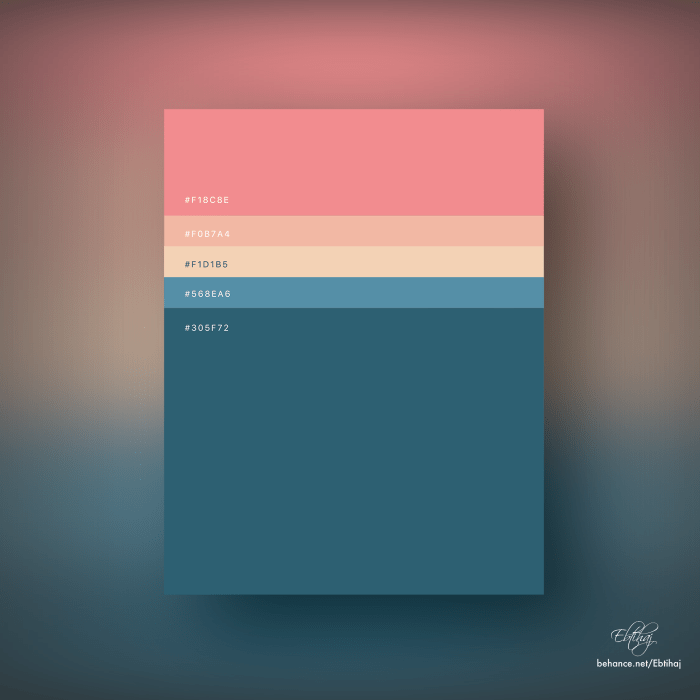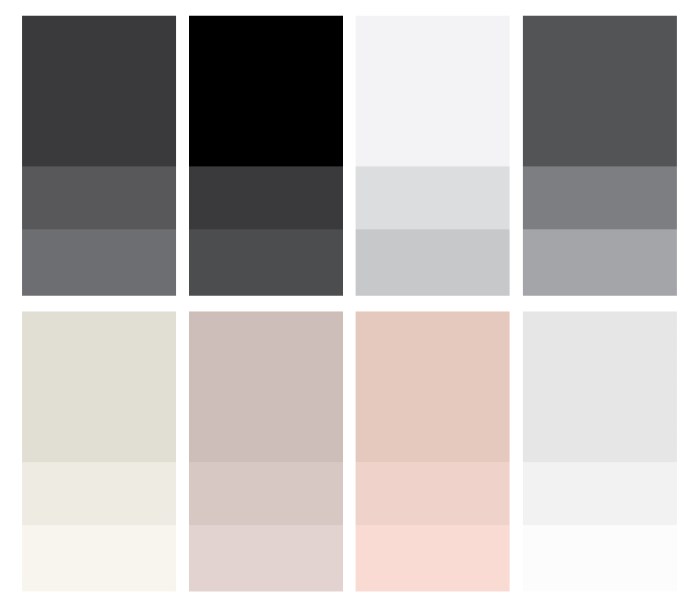
With Minimalist Design Color Palette at the forefront, this paragraph opens a window to an amazing start and intrigue, inviting readers to embark on a storytelling journey filled with unexpected twists and insights. Exploring the essence of minimalist design and its profound impact on color choices, this discussion delves into the art of simplicity in a visually captivating manner.
From unraveling the significance of minimalist color palettes to exploring their influence on modern classics and contemporary living spaces, this exploration promises to offer a fresh perspective on design aesthetics that blend functionality with elegance.
Minimalist Design Color Palette

Minimalist design is a style that emphasizes simplicity and functionality by stripping away unnecessary elements to focus on essential components. This approach values clean lines, open spaces, and a sense of calmness.
Key Characteristics of a Minimalist Color Palette
A minimalist color palette typically consists of neutral tones such as white, black, gray, and beige. These colors create a sense of sophistication and elegance while maintaining a minimalist aesthetic. Limited use of color is also a common characteristic, with an emphasis on creating a harmonious and balanced look.
How Color Influences Minimalist Design
Color plays a crucial role in minimalist design by setting the tone and mood of a space. Neutral colors help to create a sense of tranquility and simplicity, while also allowing other design elements to stand out. Additionally, the use of color in a minimalist palette can evoke a sense of warmth, serenity, or modernity.
Popular Color Schemes in Minimalist Design
- Black and White: Classic and timeless, this color scheme creates a strong contrast while maintaining a minimalist look.
- Monochromatic: Using varying shades of a single color adds depth and visual interest to a minimalist space.
- Neutral with a Pop of Color: Incorporating a subtle pop of color, such as a soft pastel or muted tone, can add a touch of personality to a minimalist design.
Modern Classics in Minimalist Design
In the realm of design, minimalist aesthetics have stood the test of time and continue to influence modern classics. Let’s delve into the evolution of minimalist design in these timeless pieces.
Evolution of Minimalist Design
Minimalist design has roots in the early 20th century with movements like Bauhaus and De Stijl, focusing on simplicity, clean lines, and functionality. In modern classics, we see a refinement of these principles with a contemporary twist, emphasizing sleek forms and a sense of calm.
Comparison of Minimalist Elements
- Classic: Minimalist design in classic settings often features neutral hues, simple shapes, and a focus on negative space.
- Contemporary: In modern classics, we see a play with textures, subtle patterns, and a mix of materials while still maintaining the essence of minimalism.
Role of Color Palettes
Color palettes play a crucial role in modern classics, with hues like white, black, gray, and earth tones dominating the scene. These colors create a sense of harmony and sophistication, enhancing the minimalist aesthetic.
Iconic Pieces in Modern Classics
One iconic piece that defines modern classics in minimalist design is the Barcelona Chair by Ludwig Mies van der Rohe. Its sleek leather upholstery and chrome frame embody the essence of minimalism.
Another example is the Eames Lounge Chair by Charles and Ray Eames, known for its timeless design featuring clean lines and organic shapes.
Modern Living and Minimalist Design

In today’s fast-paced world, modern living spaces are often characterized by clutter and chaos. However, minimalist design offers a refreshing and calming approach to interior decor, creating a sense of simplicity and order.Minimalist design enhances functionality in modern homes by promoting clean lines, open spaces, and a clutter-free environment. This design philosophy prioritizes essential elements and eliminates unnecessary distractions, allowing for better organization and efficiency in daily living.
Incorporating Minimalist Color Palettes
Minimalist color palettes play a crucial role in achieving a minimalist aesthetic in contemporary interiors. To incorporate these color schemes effectively, consider using neutral tones such as white, beige, gray, and black as the foundation. Add subtle pops of color sparingly to create visual interest without overwhelming the space.
- Avoid cluttering the space with too many colors; stick to a cohesive color scheme to maintain a minimalist look.
- Use natural materials like wood and stone to add warmth and texture to the space while maintaining a clean and minimalist feel.
- Opt for furniture with simple and sleek designs to complement the minimalist color palette and overall aesthetic of the room.
Impact of Minimalist Design on Lifestyle and Well-being
Embracing minimalist design principles can have a profound impact on lifestyle and well-being. By creating a serene and harmonious living environment, minimalist design can reduce stress, promote relaxation, and enhance overall mental clarity.
Minimalist interiors can contribute to a sense of mindfulness and tranquility, allowing individuals to focus on what truly matters and declutter both their physical space and mental state.
In conclusion, Minimalist Design Color Palette transcends mere visual appeal to encapsulate a lifestyle marked by sophistication and balance. By embracing the power of minimalism in color selection, one can elevate any space into a harmonious sanctuary of style and serenity. Dive into the world of minimalist design and pave the way for a refined, uncluttered living experience.
Clarifying Questions
What defines a minimalist design color palette?
A minimalist design color palette typically consists of neutral tones, such as whites, grays, and blacks, with occasional pops of muted colors for contrast.
How does color influence minimalist design?
Color plays a crucial role in minimalist design by creating a sense of harmony, simplicity, and visual balance within a space.
What are some popular color schemes used in minimalist design?
Popular color schemes in minimalist design include monochromatic schemes, complementary colors, and analogous color palettes.
How does minimalist design enhance functionality in modern homes?
Minimalist design focuses on decluttering spaces and emphasizing essential elements, promoting a sense of calm and organization in modern living environments.
What impact does minimalist design have on lifestyle and well-being?
Minimalist design is known to promote a stress-free environment, encourage mindfulness, and create a sense of tranquility, ultimately enhancing well-being and quality of life.






